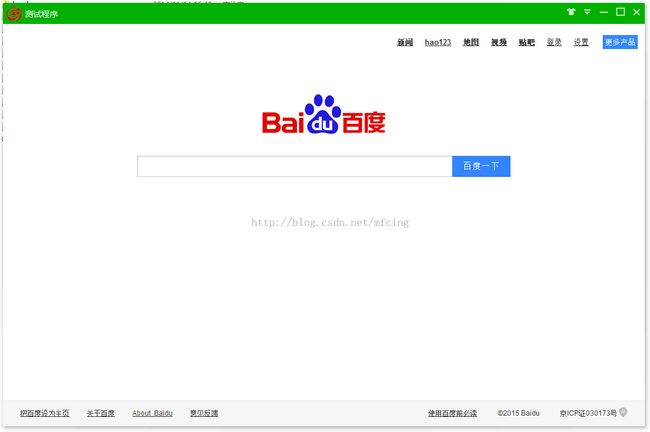libCEF中C++与JavaScript的交互调
前言
前一篇文章介绍过CEF在WIN32程序中嵌入chrome内核浏览器的例子:http://blog.csdn.net/mfcing/article/details/43973377
这里介绍的是嵌入浏览器后,网页的JS脚本函数与C++代码的交互,这个很多地方都用得到。比如:音乐播放器里网页上的播放,客户端资源中心里的资源下载……
JS调用C++函数
首先需要重写CefRenderProcessHandler的OnContextCreated接口,为什么呢?学习CEF库的使用必须仔细阅读他的头文件里的注视部分:
// Called immediately after the V8 context for a frame has been created. To
// retrieve the JavaScript 'window' object use the CefV8Context::GetGlobal()
// method. V8 handles can only be accessed from the thread on which they are
// created. A task runner for posting tasks on the associated thread can be
// retrieved via the CefV8Context::GetTaskRunner() method.
///
/*--cef()--*/
virtual void OnContextCreated(CefRefPtr<CefBrowser> browser,
CefRefPtr<CefFrame> frame,
CefRefPtr<CefV8Context> context) {}这个接口实在chrome的V8引擎创建后调用的,在这里我们需要将JS里面调用的函数和C++的执行函数关联起来,这样JS就可以“执行”C++代码了。
我们的函数都是定义在window对象中的(不知道JS中这个是不是叫对象),根据注视我们需要GetGlobal获取这个对象。
我的代码是这样的:
CefRefPtr<CefV8Value> window = context->GetGlobal(); CefRefPtr<CefV8Accessor> myV8Acc = new CCefV8Accessor; CefRefPtr<CefV8Value> val = CefV8Value::CreateString(L"Application"); CefString cefException; myV8Acc->Set(L"name", window, val, cefException); CefRefPtr<CefV8Value> pObjApp = CefV8Value::CreateObject(myV8Acc); window->SetValue(L"Application", pObjApp, V8_PROPERTY_ATTRIBUTE_NONE); CefRefPtr<CefV8Handler> myV8handle = new CCefV8Handler(); CefRefPtr<CefV8Value> myFun = CefV8Value::CreateFunction(L"SetAppState", myV8handle); static_cast<CCefV8Handler*>(myV8handle.get())->AddFun(L"SetAppState", &CChromeJsCallback::JsSetAppState); pObjApp->SetValue(L"SetAppState", myFun, V8_PROPERTY_ATTRIBUTE_NONE); myFun = CefV8Value::CreateFunction(L"OneClickInstall", myV8handle); static_cast<CCefV8Handler*>(myV8handle.get())->AddFun(L"OneClickInstall", &CChromeJsCallback::JsOneKeyInstall); pObjApp->SetValue(L"OneClickInstall", myFun, V8_PROPERTY_ATTRIBUTE_NONE); myFun = CefV8Value::CreateFunction(L"DownLoadFile", myV8handle); static_cast<CCefV8Handler*>(myV8handle.get())->AddFun(L"DownLoadFile", &CChromeJsCallback::JsDownloadFile); pObjApp->SetValue(L"DownLoadFile", myFun, V8_PROPERTY_ATTRIBUTE_NONE);
所有的JS函数都是在window.Application上的,因此需要在window 对象上面创建Application 对象,CefV8Value::CreateObject用来创建对象。CefV8Value这个类在JS处理中至关重要,要必要好好看看头文件里面的注视,CEF的注视是相当详细的。
创建函数对象,并将JS函数绑定到C++函数指针上面的过程是重点详细介绍下
CefRefPtr<CefV8Handler> myV8handle = new CCefV8Handler(); CefRefPtr<CefV8Value> myFun = CefV8Value::CreateFunction(L"SetAppState", myV8handle); static_cast<CCefV8Handler*>(myV8handle.get())->AddFun(L"SetAppState", &CChromeJsCallback::JsSetAppState); pObjApp->SetValue(L"SetAppState", myFun, V8_PROPERTY_ATTRIBUTE_NONE);
AddFun是自己添加的一个函数,用来把一个函数和气对应的回调地址存储到这个V8对象中,因此用了一个成员变量typedef map<CefString, JS_CALLBACK_FUN> FunctionMap,调用函数时V8引擎有一个接口Execute,在这里我们调用函数的名称到map中去查找,找到了其对应的回调地址调用函数,这就是JS调用C++的过程了。
最上面那段代码中,我们又添加了三个函数 SetAppState、OneClickInstall、DownLoadFile到window.application对象上面。
C++代码中,这三个函数是这样写的:
//JS函数,在其他进程中调用 static bool JsSetAppState(const CefV8ValueList& argList, CefRefPtr<CefV8Value>& retValue); static bool JsOneKeyInstall(const CefV8ValueList& argList, CefRefPtr<CefV8Value>& retValue); static bool JsDownloadFile(const CefV8ValueList& argList, CefRefPtr<CefV8Value>& retValue);
vCefV8ValueList是一个参数列表,看它的定义typedef std::vector<CefRefPtr<CefV8Value> > CefV8ValueList,retValue当然就是函数的返回值了,有的JS需要根据返回值做相应的处理的。
这里要注意:CEF可以使用单进程和多进程模式,我程序里使用的是多进程模式,因此V8引擎的执行是在渲染引擎里的,不要尝试在这里直接去对界面进行处理。界面进程和渲染进程是分开的,数据的话用共享内存来做,界面更新发消息来做。
C++调用JS函数
C++调用JS函数相对简单多了,因为CEF有接口可以直接使用CefFrame::ExecuteJavaScript,看看注释:
// Execute a string of JavaScript code in this frame. The |script_url|
// parameter is the URL where the script in question can be found, if any.
// The renderer may request this URL to show the developer the source of the
// error. The |start_line| parameter is the base line number to use for error
// reporting.
///
/*--cef(optional_param=script_url)--*/
virtual void ExecuteJavaScript(const CefString& code,
const CefString& script_url,
int start_line) =0;
首先需要获取到我们的浏览器里的主框架对象,code是JS函数和传入参数的字符串,URL可以直接忽略。
void CChromeBrowserUI::ExecuteJavascript( const wstring& strCode )
{
if ( m_pWebBrowser.get() )
{
CefRefPtr<CefFrame> frame = m_pWebBrowser->GetMainFrame();
if ( frame.get() )
{
CefString strCode(strCode.c_str()), strUrl(L"");
frame->ExecuteJavaScript(strCode, strUrl, 0);
}
}
}注意:函数名和参数名需要用单引号分隔。
我的字符串格式化部分:
CString strJsCode;
strJsCode.Format(L"setInstallStatus('%s','%s','%d');", lpData->strId.c_str(), strStatus, nPercent);
这样,C++就可以调用JS的函数并传入对应的参数了。
总结
要想使用CEF,最好还是仔细阅读头文件里面的注释,很详细。
运行程序
